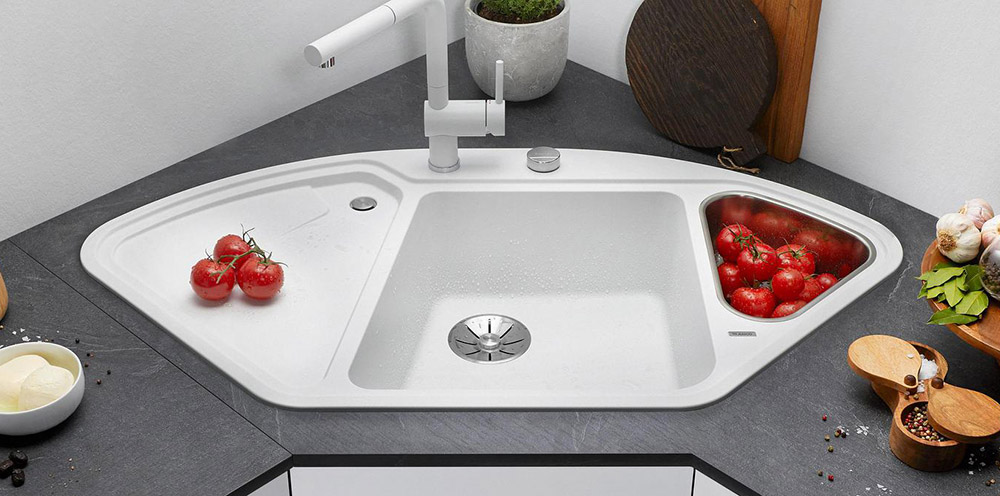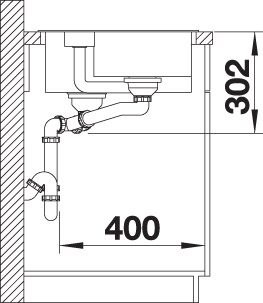INSET SINKS
Inset sinks are possibly one of the most functional and useful additions to a kitchen. Often incorporating there own purpose drainer area in one whole unit, there are a dizzying amount of options and versions available. One or several bowls, with or without a drainer, square, rectangular, round or as a corner sink, you’re spoilt for choice. They also come in different materials such as Stainless steel, composite (Granite & resin mix), Ceramic and even glass !
Also known as overmount sinks, inset sinks are the most popular type of kitchen sink and are the most straightforward to install. The inset sink is mounted from above, whereby the bowl drops into a hole prepared in the work surface and the rim then overlaps and rests on the top.
Inset sink – Ceramic
Ceramic Inset sinks as show above as easy to maintain and will lats a lifetime if looked after. Ceramic sinks can also withstand very high temperatures so you don’t need to worry about pouring boiling water on them. They are also highly resistant to household cleaning products, making them a great choice.
Inset sink – Stainless steel
The image above shows a stainless steel 1.5 sink with its own drainer as one complete unit. While the stainless steel version is usually the best priced option, Stainless steel will scratch over time so other options often give better value for money over the long term.
Inset sink – Composite
The above image shows an inset sink with its own drainer board area. These type of sinks are a composite material made of up to 80% natural granite (quartz sand) mixed with acrylic resin. The surface is repellent and will not absorb liquids.
Inset sink – Corner mounted
Corner mounted inset sinks are a great option if you have a smaller kitchen and limited space. With a compact & space saving design corner sinks are great for homes that have an unusual kitchen layout. Different finishes are available including stainless steel, composite and ceramic.
Sink type, make & model
The cut-out size for the specific sink you have chosen is a crucial piece of information as each sink will be different. You will need to obtain the exact make & model of your sink along with the cut out dimensions to supply to our fitting teams on the day templates/ measurements are taken for your new worktops.
The actual cut out sizes we would need should be readily available from the sink manufacturers website. this information is either directly on the page or from a downloadable product sheet/ specification guide attachment.
The first example on the right shows the overall sink sizes & basic information supplied by the sink manufacturer. However, this does not show us the actual sizes needed for the cut out.
The example to the far right right shows the product sheet that accompanies the sink, showing all the relevant cut out dimensions.
Usually with this type of sink the cut out required is simply a rectangle with radius corners. If you are unable to obtain the cut out sizes from the sink supplier, it’s possible that our fitters may be able to physically measure the sink to determine the cut out size, as long as the sink is available on site at the template stage.
Overall sink sizes
Sink cut out dimensions
Choosing the correct sink
Sink size & position
When choosing your sink its important to make sure it will fit within the unit. Usually the sink product information will have a dimensioned sketch with a side and front view.
The sizes of the cut out needed in the worktops can be very close to the actual sink size, yet often the whole of the sink unit will not sit anywhere below the depth of the worktop. Generally this is for inset sinks that have an integrated draining board & sink , all in one. The drainer board area could quite happily sit over a dishwasher, while the only part of the whole sink unit that needs to sit into a cupboard would be the actual bowls.
When the fitter arrives on site to make the template/ take sizes you will need to confirm the position of the sink within the unit. Sometimes, due to other constraints, the sink may need to be fitted off centre, to the left or right of the unit it will sit into.











